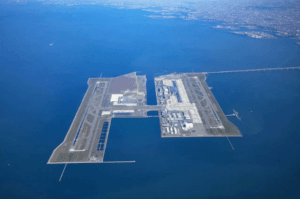China is on the brink of setting another world record, and this time it’s not a skyscraper, a bullet train, or a mega-dam. Instead, the nation is constructing what will soon be the world’s largest artificial island airport a game-changing infrastructure project that promises to turn Dalian, a bustling northeastern port city, into a powerful regional transport hub. Welcome to the future of aviation: the Dalian Jinzhouwan International Airport.
With an investment of $4.3 billion and an anticipated completion date of 2035, this engineering marvel is a testament to China’s relentless drive for progress. But what makes this airport special, and why should the world take note? Buckle up as we explore the incredible scale, significance, and innovation behind Dalian’s colossal new aviation project.
Bigger Than the Giants: Setting New Records
When you hear “artificial island airport,” the first names that come to mind are probably Hong Kong International Airport (12.48 sq km) and Kansai Airport (10.5 sq km) near Osaka, Japan. These airports have long been marvels of modern engineering, seamlessly blending infrastructure with innovation.

But China, never one to shy away from big challenges, is about to outdo them both. Dalian Jinzhouwan International Airport will sprawl over an impressive 20.9 square kilometers (7.72 square miles), making it the largest of its kind in the world reported SCMP.
For the people of Dalian, the phrase “world’s largest” isn’t just marketing hype. As Li Hanming, founder of an aviation consultancy, confidently put it, “For Dalian people to say it’s the world’s largest artificial island airport, that’s exactly what it is.” And they are not wrong.
Why Dalian? The Perfect Geographical Sweet Spot
Nestled on a peninsula at the northern tip of the Bohai Strait, Dalian’s strategic location makes it a gateway to Japan and South Korea. With a population exceeding 6 million, the city has evolved into a crucial hub for oil refineries, shipping, logistics, and coastal tourism.
The city’s existing airport, Dalian Zhoushuizi Airport, has been in operation for nearly a century, dating back to when Dalian was under Japanese occupation. Despite multiple expansions, it has reached its limit. Last year alone, it managed 658,000 international passengers, but its cramped valley location surrounded by mountains poses challenges for pilots, especially during bad weather.
Enter Jinzhouwan Airport, poised to alleviate these problems and catapult Dalian into a new era of air travel and economic prosperity.
A Feat of Modern Engineering: From Reclamation to Reality
Building an airport on an artificial island isn’t easy, it requires extraordinary engineering. The Jinzhouwan project involves advanced land reclamation techniques. Imagine millions of cubic meters of sand and rock being painstakingly deposited to create this island. As of August, work on the 77,000-square-meter foundation was complete, with land reclamation and terminal construction poised to follow.
When finished, the world’s largest artificial-island airport will boast:
- Four runways for seamless takeoffs and landings
- A colossal 900,000 square meter terminal (9.69 million sq ft)
- An initial capacity of 43 million passengers annually, more than twice the current airport’s capacity
- Future capacity to handle 80 million passengers each year
- The ability to process 1 million tonnes of cargo annually
These numbers aren’t just impressive; they are transformative. They promise to meet the region’s skyrocketing demand for air travel and cargo transport while cementing Dalian as a major economic and logistical powerhouse.
The Stakes and Challenges: Risks of Island Airports
While the prospects are thrilling, building an airport on an artificial island comes with challenges. Island airport can be vulnerable during natural disasters. According to Li Hanming, single bridge connections to natural land can be susceptible to damage from earthquakes, typhoons, or even ship collisions.
However, China’s track record in handling large-scale infrastructure suggests they’re prepared for these challenges. If successful, this project could set new standards for resilience and safety in island-based aviation.
China’s Broader Aviation Vision
The Jinzhouwan Airport isn’t an isolated project. As of July, 22 new airports worth a combined $19.6 billion were under construction across China, according to the CAPA-Centre for Aviation. This highlights China’s commitment to expanding its aviation infrastructure and ensuring connectivity to every corner of the country.
These developments are more than just concrete and steel; they represent economic opportunities, enhanced logistics, and a better quality of life for millions. In the case of Dalian, it’s a leap toward becoming a premier international gateway.
What’s Next for Dalian? A Future-Ready City
As Dalian gears up to welcome the Jinzhouwan Airport by 2035, the city is positioning itself for a vibrant future. Increased air traffic will bolster tourism, facilitate trade, and attract international business. For travelers, businesses, and locals, the largest artificial island airport isn’t just an infrastructure project, it’s a doorway to new possibilities.
Buckle Up for Takeoff
In a world where connectivity is everything, Dalian Jinzhouwan International Airport is set to redefine regional transport and economic growth. Bigger, better, and bolder than its predecessors, this largest artificial island airport is a symbol of ambition and innovation. It’s not just about setting records, it’s about transforming lives, boosting trade, and unlocking economic potential for millions. The combination of strategic location, state-of-the-art infrastructure, and visionary planning ensures that Dalian will emerge as a key player in global aviation.

